经济学原理(第四章)
经济学原理第四章课后题答案

第四章供给与需求的市场力量复习题:1、什么是市场竞争?简单描述除了完全竞争市场之外的市场类型。
答:竞争市场是有许多买者与卖者,以至于每个人对市场价格的影响都微乎其微的市场。
除了完全竞争市场之外,还有垄断市场。
在这个市场上只有一个卖者,他决定价格。
这个卖者被称为垄断者。
还有寡头市场,在这个市场上有几个并不总是主动竞争的卖者,他们提供相似或相同的产品。
通常情况下,寡头们会尽力联合起来,防止剧烈的竞争,收取较高的市场价格。
还有垄断竞争市场,这是一个有许多提供相似但不相同产品的企业的市场结构。
由于各自提供的产品不同,每个企业对产品的价格有一定的影响力。
2、什么因素决定买者对一种物品的需求量?答:物品的价格、买者的收入、相关物品的价格、买者的嗜好、预期决定买者对一种物品的需求量。
3、什么是需求表和需求曲线?它们如何相关联?为什么需求曲线向右下方倾斜?答:需求表是表示一种物品价格与需求量之间关系的表格,需求曲线是表示一种物品价格与需求量之间关系的图形。
需求曲线将需求表用图形的形式表现出来,需求表是需求曲线上假设干个点的坐标的数字表格排列。
需求曲线向右下方倾斜是因为在其他条件不变的情况下,随着价格上升,需求量会减少。
4.消费者嗜好的变化引起了沿着需求曲线的变动,还是需求曲线的移动?价格的变化引起了沿着需求曲线的变动,还是需求曲线的移动?答:消费者嗜好的变化引起了需求曲线的移动,价格的变化引起了沿着需求曲线的变动。
5、波匹的收入减少了,结果他买了更多的菠菜。
菠菜是低档物品还是正常物品?波匹菠菜的需求曲线是什么样的?答:菠菜对波匹来说是低档物品。
因为波匹的收入减少了,他对菠菜的需求量反而增大。
波匹菠菜的需求曲线是向右下方倾斜的。
6、什么因素决定了卖者对一种物品的供给量?答:价格、投入价格、技术、预期决定了卖者对一种物品的供给量。
7、什么是供给表和供给曲线?它们如何相关联?为什么供给曲线向右上方倾斜?答:供给表是表示一种物品价格与供给量之间关系的表格,供给曲线是表示一种物品价格与供给量之间关系的图形。
曼昆经济学原理英文版教案加习题答案第4章THE MARKET FORCES OF SUPPLY AND DEMAND
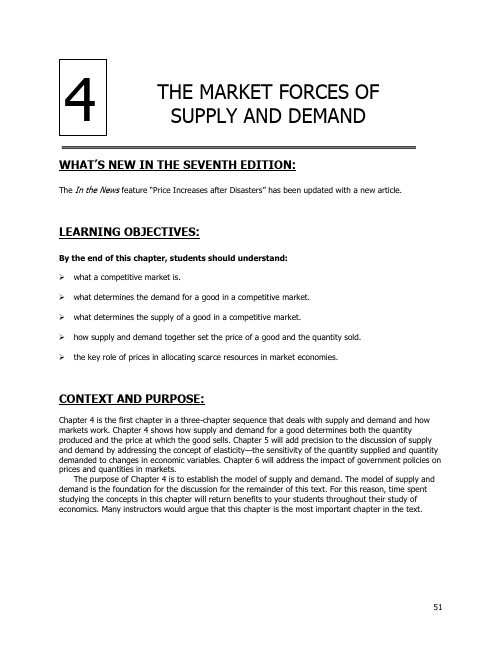
51WHAT’S NEW IN THE S EVENTH EDITION:The In the News feature “Price Increases after Disasters” has been updated with a new article.LEARNING OBJECTIVES:By the end of this chapter, students should understand:➢ what a competitive market is.➢ what determines the demand for a good in a competitive market.➢ what determines the supply of a good in a competitive market.➢ how supply and demand together set the price of a good and the quantity sold.➢ the key role of prices in allocating scarce resources in market economies.CONTEXT AND PURPOSE:Chapter 4 is the first chapter in a three-chapter sequence that deals with supply and demand and how markets work. Chapter 4 shows how supply and demand for a good determines both the quantity produced and the price at which the good sells. Chapter 5 will add precision to the discussion of supply and demand by addressing the concept of elasticity —the sensitivity of the quantity supplied and quantity demanded to changes in economic variables. Chapter 6 will address the impact of government policies on prices and quantities in markets.The purpose of Chapter 4 is to establish the model of supply and demand. The model of supply and demand is the foundation for the discussion for the remainder of this text. For this reason, time spent studying the concepts in this chapter will return benefits to your students throughout their study of economics. Many instructors would argue that this chapter is the most important chapter in the text.THE MARKET FORCES OF SUPPLY AND DEMAND52 ❖Chapter 4/The Market Forces of Supply and DemandKEY POINTS:• Economists use the model of supply and demand to analyze competitive markets. In a competitive market, there are many buyers and sellers, each of whom has little or no influence on the market price.• The demand curve shows how the quantity of a good demanded depends on the price. According to the law of demand, as the price of a good falls, the quantity demanded rises. Therefore, the demand curve slopes downward.• In addition to price, other determinants of how much consumers want to buy include income, the prices of substitutes and complements, tastes, expectations, and the number of buyers. If one of these factors changes, the demand curve shifts.• The supply curve shows how the quantity of a good supplied depends on the price. According to the law of supply, as the price of a good rises, the quantity supplied rises. Therefore, the supply curve slopes upward.• In addition to price, other determinants of how much producers want to sell include input prices, technology, expectations, and the number of sellers. If one of these factors changes, the supply curve shifts.• The intersection of the supply and demand curves determines the market equilibrium. At the equilibrium price, the quantity demanded equals the quantity supplied.• The behavior of buyers and sellers naturally drives markets toward their equilibrium. When the market price is above the equilibrium price, there is a surplus of the good, which causes the market price to fall. When the market price is below the equilibrium price, there is a shortage, which causes the market price to rise.• To analyze how any event influences a market, we use the supply-and-demand diagram to examine how the event affects equilibrium price and quantity. To do this we follow three steps. First, we decide whether the event shifts the supply curve or the demand curve (or both). Second, we decide which direction the curve shifts. Third, we compare the new equilibrium with the initial equilibrium.• In market economies, prices are the signals that guide economic decisions and thereby allocate scarce resources. For every good in the economy, the price ensures that supply and demand are in balance. The equilibrium price then determines how much of the good buyers choose to consume and how much sellers choose to produce.Chapter 4/The Market Forces of Supply and Demand ❖ 53CHAPTER OUTLINE: I. Markets and CompetitionA. What Is a Market?1. Definition of market: a group of buyers and sellers of a particular good or service.2. Markets can take many forms and may be organized (agricultural commodities) or lessorganized (ice creamB. What Is Competition?1. Definition of competitive market: a market in which there are so many buyers andso many sellers that each has a negligible impact on the market price.2. Each buyer knows that there are several sellers from which to choose. Sellers know that each buyer purchases only a small amount of the total amount sold.C. In this chapter, we will assume that markets are perfectly competitive.1. Characteristics of a perfectly competitive market:a. The goods being offered for sale are exactly the same.b. The buyers and sellers are so numerous that no single buyer or seller has any influence over the market price.2. Because buyers and sellers must accept the market price as given, they are often called "price takers."3. Not all goods are sold in a perfectly competitive market.a. A market with only one seller is called a monopoly market.b. Other markets fall between perfect competition and monopoly.54 ❖ Chapter 4/The Market Forces of Supply and DemandD. We will start by studying perfect competition.1. Perfectly competitive markets are the easiest to analyze because buyers and sellers take the price as a given.2. Because some degree of competition is present in most markets, many of the lessons that we learn by studying supply and demand under perfect competition apply in morecomplicated markets.II. DemandA. The Demand Curve: The Relationship between Price and Quantity Demanded1. Definition of quantity demanded: the amount of a good that buyers are willing andable to purchase.2. One important determinant of quantity demanded is the price of the product.a. Quantity demanded is negatively related to price. This implies that the demand curve isdownward sloping.b. Definition of law of demand: the claim that, other things being equal, thequantity demanded of a good falls when the price of the good rises .3. Definition of demand schedule: a table that shows the relationship between theprice of a good and the quantity demanded. Price of Ice-Cream ConeQuantity of Cones Demanded$0.0012 $0.5010 $1.008 $1.506 $2.004 $2.502 $3.00Figure 1Make sure that you explain that, when we discuss the relationship between quantity demanded and price, we hold all other variables constant. You will need toemphasize this more than once to ensure that students understand why a change inprice leads to a movement along the demand curve.Chapter 4/The Market Forces of Supply and Demand ❖ 554. Definition of demand curve: a graph of the relationship between the price of a good and the quantity demanded.a. Price is generally drawn on the vertical axis.b. Quantity demanded is represented on the horizontal axis. B. Market Demand versus Individual Demand1. The market demand is the sum of all of the individual demands for a particular good orservice.2. The demand curves are summed horizontally —meaning that the quantities demanded are added up for each level of price.3. The market demand curve shows how the total quantity demanded of a good varies with the price of the good, holding constant all other factors that affect how much consumers want to buy.C. Shifts in the Demand Curve1. Because the market demand curve holds other things constant, it need not be stable overtime.56 ❖ Chapter 4/The Market Forces of Supply and Demand2. If any of these other factors change, the demand curve will shift.a. An increase in demand is represented by a shift of the demand curve to the right.b. A decrease in demand is represented by a shift of the demand curve to the left.3. Incomea. The relationship between income and quantity demanded depends on what type of good the product is.b. Definition of normal good: a good for which, other things equal, an increase in income leads to an increase in demand.c. Definition of inferior good: a good for which, other things equal, an increase inincome leads to a decrease in demand.4. Prices of Related Goodsa. Definition of substitutes: two goods for which an increase in the price of one good leads to an increase in the demand for the other.b. Definition of complements: two goods for which an increase in the price of one good leads to a decrease in the demand for the other.5. Tastes6. Expectationsa. Future incomeb. Future prices7. Number of BuyersChapter 4/The Market Forces of Supply and Demand ❖57D. Case Study: Two Ways to Reduce the Quantity of Smoking Demanded1. Public service announcements, mandatory health warnings on cigarette packages, and theprohibition of cigarette advertising on television are policies designed to reduce the demandfor cigarettes (and shift the demand curve to the left).2. Raising the price of cigarettes (through tobacco taxes) lowers the quantity of cigarettesdemanded.a. The demand curve does not shift in this case, however.b. An increase in the price of cigarettes can be shown by a movement along the originaldemand curve.3. Studies have shown that a 10% increase in the price of cigarettes causes a 4% reduction inthe quantity of cigarettes demanded. For teens, a 10% increase in price leads to a 12% dropin quantity demanded.4. Studies have also shown that a decrease in the price of cigarettes is associated with greateruse of marijuana. Thus, it appears that tobacco and marijuana are complements.III. SupplyA. The Supply Curve: The Relationship between Price and Quantity Supplied1. Definition of quantity supplied: the amount of a good that sellers are willing andable to sell.a. Quantity supplied is positively related to price. This implies that the supply curve will beupward sloping.b. Definition of law of supply: the claim that, other things equal, the quantitysupplied of a good rises when the price of the good rises.2. Definition of supply schedule: a table that shows the relationship between the priceof a good and the quantity supplied.58 ❖ Chapter 4/The Market Forces of Supply and Demand3. Definition of supply curve: a graph of the relationship between the price of a good and the quantity supplied. Price of Ice-Cream ConeQuantity of Cones Supplied$0.000 $0.50 0 $1.001 $1.502 $2.003 $2.504 $3.005B. Market Supply versus Individual Supply1. The market supply curve can be found by summing individual supply curves.2. Individual supply curves are summed horizontally at every price.3. The market supply curve shows how the total quantity supplied varies as the price of thegood varies.C. Shifts in the Supply Curve1. Because the market supply curve holds other things constant, the supply curve will shift ifany of these factors changes.a. An increase in supply is represented by a shift of the supply curve to the right.b. A decrease in supply is represented by a shift of the supply curve to the left.Figure 5Figure 7Figure 6You will want to take time to emphasize the difference between a “change in supply” and a “change in quantity supplied.”Chapter 4/The Market Forces of Supply and Demand ❖ 592. Input Prices3. Technology4. Expectations5. Number of Sellers IV. Supply and Demand TogetherA. Equilibrium1. The point where the supply and demand curves intersect is called the market’s equilibrium.2. Definition of equilibrium: a situation in which the market price has reached thelevel at which quantity supplied equals quantity demanded.3. Definition of equilibrium price: the price that balances quantity supplied andquantity demanded.4. The equilibrium price is often called the "market-clearing" price because both buyers andsellers are satisfied at this price.Table 2Figure 8 Students will benefit from seeing equilibrium using both a graph and a supply-and-demand schedule. The schedule will also make it easier for students to understand concepts such as shortages and surpluses.60 ❖Chapter 4/The Market Forces of Supply and Demand5. Definition of equilibrium quantity: the quantity supplied and the quantitydemanded at the equilibrium price.6. If the actual market price is higher than the equilibrium price, there will be a surplus of thegood.Figure 9a. Definition of surplus: a situation in which quantity supplied is greater thanquantity demanded.b. To eliminate the surplus, producers will lower the price until the market reachesequilibrium.7. If the actual price is lower than the equilibrium price, there will be a shortage of the good.a. Definition of shortage: a situation in which quantity demanded is greater thanquantity supplied.b. Sellers will respond to the shortage by raising the price of the good until the marketreaches equilibrium.8. Definition of the law of supply and demand: the claim that the price of any goodadjusts to bring the supply and demand for that good into balance.B. Three Steps to Analyzing Changes in Equilibrium 1. Decide whether the event shifts the supply or demand curve (or perhaps both). 2. Determine the direction in which the curve shifts.3. Use the supply-and-demand diagram to see how the shift changes the equilibrium price andquantity. C. Example: A change in market equilibrium due to a shift in demand —the effect of hot weather onthe market for ice cream.D. Shifts in Curves versus Movements along Curves1. A shift in the demand curve is called a "change in demand." A shift in the supply curve iscalled a "change in supply."2. A movement along a fixed demand curve is called a "change in quantity demanded." Amovement along a fixed supply curve is called a "change in quantity supplied." E. Example: A change in market equilibrium due to a shift in supply —the effect of a hurricane thatdestroys part of the sugar-cane crop and drives up the price of sugar.F. Example: Shifts in both supply and demand —the effect of hot weather and a hurricane thatdestroys part of the sugar cane crop. G. Summary1. When an event shifts the supply or demand curve, we can examine the effects on theequilibrium price and quantity.ALTERNATIVE CLASSROOM EXAMPLE:Go through these examples of events that would shift either the demand or supply of #2 lead pencils:▪ an increase in the income of consumers▪ an increase in the use of standardized exams (using opscan forms) ▪ a decrease in the price of graphite (used in the production of pencils) ▪ a decrease in the price of ink pens ▪ the start of a school year▪ new technology that lowers the cost of producing pencils.2. Table 4 reports the end results of these shifts in supply and demand.H. In the News: Price Increases after Disasters1. When a disaster strikes a region, many good experience an increase in demand or a decreasein supply resulting in upward pressure on prices.2. This article from defends price increases following natural disasters as a naturalresult of market interactions.V. Conclusion: How Prices Allocate ResourcesA. The model of supply and demand is a powerful tool for analyzing markets.B. Supply and demand together determine the prices of the economy’s goods and services.1. These prices serve as signals that guide the allocation of scarce resources in the economy.2. Prices determine who produces each good and how much of each good is produced.SOLUTIONS TO TEXT PROBLEMS:Quick Quizzes1. A market is a group of buyers (who determine demand) and a group of sellers (whodetermine supply) of a particular good or service. A perfectly competitive market is one inwhich there are many buyers and many sellers of an identical product so that each has anegligible impact on the market price.2. Here is an example of a monthly demand schedule for pizza:Price of Pizza Slice Number of Pizza Slices Demanded$ 0.00 100.25 90.50 80.75 71.00 61.25 51.50 41.75 32.00 22.25 12.50 0The demand curve is graphed in Figure 1.Figure 1Examples of things that would shift the demand curve include changes in income, prices ofrelated goods like soda or hot dogs, tastes, expectations about future income or prices, andthe number of buyers.A change in the price of pizza would not shift this demand curve; it would only lead to amovement from one point to another along the same demand curve.3. Here is an example of a monthly supply schedule for pizza:Price of Pizza Slice Number of PizzaSlices Supplied$ 0.00 00.25 1000.50 2000.75 3001.00 4001.25 5001.50 6001.75 7002.00 8002.25 9002.50 1000The supply curve is graphed in Figure 2.Figure 2Figure 3Examples of things that would shift the supply curve include changes in prices of inputs like tomato sauce and cheese, changes in technology like more efficient pizza ovens or automatic dough makers, changes in expectations about the future price of pizza, or a change in the number of sellers.A change in the price of pizza would not shift this supply curve; it would only lead to amovement from one point to another along the same supply curve.4. If the price of tomatoes rises, the supply curve for pizza shifts to the left because there hasbeen an increase in the price of an input into pizza production, but there is no shift indemand. The shift to the left of the supply curve causes the equilibrium price to rise and the equilibrium quantity to decline, as Figure 3 shows.If the price of hamburgers falls, the demand curve for pizza shifts to the left because thelower price of hamburgers will lead consumers to buy more hamburgers and fewer pizzas,but there is no shift in supply. The shift to the left of the demand curve causes theequilibrium price to fall and the equilibrium quantity to decline, as Figure 4 shows.Figure 4Questions for Review1. A competitive market is a market in which there are many buyers and many sellers of anidentical product so that each has a negligible impact on the market price. Another type ofmarket is a monopoly, in which there is only one seller. There are also other markets that fallbetween perfect competition and monopoly.2. The demand schedule is a table that shows the relationship between the price of a good andthe quantity demanded. The demand curve is the downward-sloping line relating price andquantity demanded. The demand schedule and demand curve are related because thedemand curve is simply a graph showing the points in the demand schedule.The demand curve slopes downward because of the law of demand—other things beingequal, when the price of a good rises, the quantity demanded of the good falls. People buyless of a good when its price rises, both because they cannot afford to buy as much andbecause they switch to purchasing other goods.3. A change in consumers' tastes leads to a shift of the demand curve. If the change inconsumers' tastes leads to an increase in demand, consumers want to buy more of this goodat every price level. A change in price leads to a movement along the demand curve.Because price is measured on the vertical axis, a change in the price represents a movementalong the demand curve.4. Because Popeye buys more spinach when his income falls, spinach is an inferior good for him.His demand curve for spinach shifts out to the right as a result of the decrease in his income.5. A supply schedule is a table showing the relationship between the price of a good and thequantity a producer is willing and able to supply. The supply curve is the upward-sloping linerelating price and quantity supplied. The supply schedule and the supply curve are related because the supply curve is simply a graph showing the points in the supply schedule.The supply curve slopes upward because when the price is high, suppliers' profits increase, so they supply more output to the market. The result is the law of supply—other things being equal, when the price of a good rises, the quantity supplied of the good also rises.6. A change in producers' technology leads to a shift in the supply curve. A change in priceleads to a movement along the supply curve.7. The equilibrium of a market is the point at which the quantity demanded is equal to quantitysupplied. If the price is above the equilibrium price, sellers want to sell more than buyers want to buy, so there is a surplus. Sellers try to increase their sales by cutting prices. That continues until they reach the equilibrium price. If the price is below the equilibrium price, buyers want to buy more than sellers want to sell, so there is a shortage. Sellers can raise their price without losing customers. That continues until they reach the equilibrium price.8. When the price of beer rises, the demand for pizza declines, because beer and pizza arecomplements and people want to buy less beer. When we say the demand for pizza declines, we mean that the demand curve for pizza shifts to the left as in Figure 5. The supply curve for pizza is not affected. With a shift to the left in the demand curve, the equilibrium price and quantity both decline, as the figure shows. Thus, the quantity of pizza supplied anddemanded both fall. In sum, supply is unchanged, demand is decreased, quantity supplied declines, quantity demanded declines, and the price falls.Figure 59. Prices play a vital role in market economies because they bring markets into equilibrium. Ifthe price is different from its equilibrium level, quantity supplied and quantity demanded are not equal. The resulting surplus or shortage leads suppliers to adjust the price untilequilibrium is restored. Prices thus serve as signals that guide economic decisions andallocate scarce resources.Quick Check Multiple Choice1. b2. b3. d4. b5. a6. cProblems and Applications1. a. Cold weather damages the orange crop, reducing the supply of oranges and raising theprice of oranges. This leads to a decline in the supply of orange juice because orangesare an important input in the production of orange juice. This can be seen in Figure 6 asa shift to the left in the supply curve for orange juice. The new equilibrium price is higherthan the old equilibrium price.Figure 6b. People often travel to the Caribbean from New England to escape cold weather, so thedemand for Caribbean hotel rooms is high in the winter. In the summer, fewer peopletravel to the Caribbean, because northern climates are more pleasant. The result, asshown in Figure 7, is a shift to the left in the demand curve. The equilibrium price ofCaribbean hotel rooms is thus lower in the summer than in the winter, as the figureshows.Figure 7c. When a war breaks out in the Middle East, many markets are affected. Because a largeproportion of oil production takes place there, the war disrupts oil supplies, shifting thesupply curve for gasoline to the left, as shown in Figure 8. The result is a rise in theequilibrium price of gasoline. With a higher price for gasoline, the cost of operating agas-guzzling automobile like a Cadillac will increase. As a result, the demand for usedCadillacs will decline, as people in the market for cars will not find Cadillacs as attractive.In addition, some people who already own Cadillacs will try to sell them. The result isthat the demand curve for used Cadillacs shifts to the left, while the supply curve shifts to the right, as shown in Figure 9. The result is a decline in the equilibrium price of used Cadillacs.Figure 8 Figure 92. The statement is false. As Figure 10 shows, in equilibrium the increase in demand fornotebooks results in an increased quantity demanded and the quantity supplied.Figure 10 Figure 113. a. If people decide to have more children, they will want larger vehicles for hauling theirkids around, so the demand for minivans will increase. Supply will not be affected. The result is a rise in both the price and the quantity sold, as Figure 12 shows.Figure 12 Figure 13b. If a strike by steelworkers raises steel prices, the cost of producing a minivan rises andthe supply of minivans decreases. Demand will not be affected. The result is a rise in the price of minivans and a decline in the quantity sold, as Figure 13 shows.c. The development of new automated machinery for the production of minivans is animprovement in technology. This reduction in firms' costs will result in an increase in supply. Demand is not affected. The result is a decline in the price of minivans and an increase in the quantity sold, as Figure 14 shows.Figure 14d. The rise in the price of sport utility vehicles affects minivan demand because sport utilityvehicles are substitutes for minivans. The result is an increase in demand for minivans.Supply is not affected. The equilibrium price and quantity of minivans both rise, as Figure12 shows.e. The reduction in peoples' wealth caused by a stock-market crash reduces their income,leading to a reduction in the demand for minivans, because minivans are likely a normal good. Supply is not affected. As a result, both the equilibrium price and the equilibrium quantity decline, as Figure 15 shows.Figure 154. a. DVDs and TV screens are likely to be complements because you cannot watch a DVDwithout a television. DVDs and movie tickets are likely to be substitutes because a movie can be watched at a theater or at home. TV screens and movie tickets are likely to besubstitutes for the same reason.b. The technological improvement would reduce the cost of producing a TV screen, shiftingthe supply curve to the right. The demand curve would not be affected. The result is that the equilibrium price will fall, while the equilibrium quantity will rise. This is shown inFigure 16.Figure 16c. The reduction in the price of TV screens would lead to an increase in the demand forDVDs because TV screens and DVDs are complements. The effect of this increase in the demand for DVDs is an increase in both the equilibrium price and quantity, as shown inFigure 17.Figure 17The reduction in the price of TV screens would cause a decline in the demand for movie tickets because TV screens and movie tickets are substitute goods. The decline in thedemand for movie tickets would lead to a decline in the equilibrium price and quantitysold. This is shown in Figure 18.Figure 185. Technological advances that reduce the cost of producing computer chips represent a declinein an input price for producing a computer. The result is a shift to the right in the supply of computers, as shown in Figure 19. The equilibrium price falls and the equilibrium quantity rises, as the figure shows.Figure 19Because computer software is a complement to computers, the lower equilibrium price of computers increases the demand for software. As Figure 20 shows, the result is a rise in both the equilibrium price and quantity of software.Figure 20Because typewriters are substitutes for computers, the lower equilibrium price of computers reduces the demand for typewriters. As Figure 21 shows, the result is a decline in both the equilibrium price and quantity of typewriters.Figure 216. a. When a hurricane in South Carolina damages the cotton crop, it raises input prices forproducing sweatshirts. As a result, the supply of sweatshirts shifts to the left, as shownin Figure 22. The new equilibrium price is higher and the new equilibrium quantity ofsweatshirts is lower.。
2023版经济学原理名词解释

2023版经济学原理名词解释第一章1.稀缺性:社会拥有的资源是有限的,因此不能生产人们希望用油的所有物品与劳务2.经济学:研究社会如何管理自己的稀缺资源3.效率:社会能从稀缺资源中得到的最大利益4.平等:讲这些资源的成果平均地分配给社会成员5.机会成本:为了得到这种东西所放弃的东西6.理性人:能系统而由母的的尽最大努力去实现目标7.编辑变动:对现有行动计划的微小增量调整8.激励:引起一个人做出某种行为的某种东西9.市场失灵:市场本身不能有效配置资源的情况10.外部性:一个人的行为对旁观者福利的影响11.市场势力:单个人或者一小群人不适当地影响市场价格的能力12.生产率:每一单位劳动投入所生产的物品与劳动数量经济学十大原理L人们面临权衡取舍2、某种东西的成本是为了得到它所放弃的东西3、理性人考虑边际量4、人们会对激励做出反应5、毛衣可以使每个人的状况都变得更好6、市场通常是组织经济活动的一种好方法7、政府又是可以改善市场结果8、一国的生活水平取决于它生产物品与劳务的能力9、当政府发行了过多的货币时,物价上升10、社会面临通货膨胀与事业之间的短期权衡取舍第二章要点1.循环流向图,见书20o在这个模型中,经济由两类觉得这,家庭和企业组成,2.物品与劳务市场上,家庭是买者,生产要素市场上,家庭是卖者3.生产可能性边界:一个图形,标明在生产要素和生产技术既定时,一个经济所能生产的产出。
大炮与黄油4.微观经济学:研究家庭和企业如何做出决策,以及他们如何在特定市场上相互影响5.宏观经济学:研究整体经济现象6.关于世界的表述有两种类型:一,实证表述:描述性的,关于世界是什么样子的表述;二,规范表述:关于世界应该是什么样子的表述第四章供给与需求的市场力量L某种物品与劳务的买者与卖者组成的一个群体2、竞争市场:有许多买者与卖者,以至于一个人对市场价格的影响微乎其微的市场3、完全竞争的市场具有的两个特征:可供销售的物品是完全相同的;买者与卖者众多以至于任何一个买者或卖者无法影响市场价格,此时他们被称为价格接受者4、垄断者:一些市场只有一个卖者,由他决定价格5.需求量:买者愿意并且能够购买的该种物品的数量6.需求定理:在其他条件不变的情况下,价格上升,该物品的需求量减少,价格下降,需求量增加7.需求曲线:把价格与需求量联系一起的向右下方倾斜的曲线8.市场需求:所有个人对某种特定物品或劳务的需求的总和9.需求变动:需求曲线向右移动为去求增加,向左移动为需求减少10.影响需求量的因素:价格11.影响需求的因素:收入,相关物品的价格,嗜好,预期,买者数量12.供给量:卖者愿意并且能够出售的该种物品的数量13.供给定理:在其他条件不变时,一种物品价格上升,该物品的供给量增加,一种物品价格下降,该物品供给量减少14.供给变动:供给曲线向右移动,为供给增加,供给曲线向左移动,为供给减少15.影响供给的因素:投入品的价格,技术,预期,卖者数量16.分析均衡变动的三个步骤:一,确定该事件是使供给曲线移动还是使需求曲线移动,还是两者都移动;二,确定曲线移动方向;三。
《经济学原理》课件
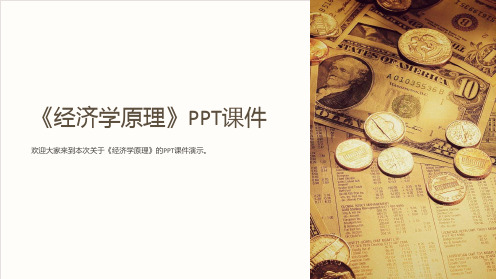
垄断市场
讨论一家企业垄断市场的情况下 的定价和产量决策。
寡头垄断市场
探讨少数几家企业控制市场的情 况下的竞争和合作。
第五章:资源市场与收入分配
劳动力市场
解释劳动市场中工资的决定 因素。
租金市场
讨论土地和资本等资源的收 入分配。
收入不平等
分析不同收入组群间的差距 和所导致的社会经济问题。
目录
第一章:供给与需求
探讨市场中商品供给和需求 的关系,以及价格和数量的 决定。
第二章:消费者行为
研究个人消费者在购买决策 中的偏好和限制。
第三章:生产与成本
讨论企业生产决策和成本结 构对产量和价格的影响。
第四章:市场结构
介绍市场的类型和特征,及其对企业行为和市 场效率的影响。
第五章:资源市场与收入分配
总结
通过本次课件演示,我们深入探讨了经济学原理中的关键概念和理论模型,希望对大家的经济学学习有所帮助。
《经济学原理》PPT课件
欢迎大家来到本次关于《经济学原理》的PPT课件演示。
作者简介
Adam Smith
被公认为现代经济学之父, 提出了自由市场经济的理论。
John Maynard Keynes
对宏观经济学做出了重要贡 献,强调政府在经济中的作 用。
Milton Friedman
代表自由市场经济学派,主 张个人自由和经济自由。
探讨劳动力和其他生产要素在市场中的价格和 分配。
第一章:供给与需求
1
供给曲线
2
揭示企业在不同价格下提供商品和服务
的情况。
3
需求曲线
解释消费者购买商品的决策和需求的变 化。
4经济学原理 第四章

(2)生产的正外部性
机器人 价格
技术溢出 效应的价值
Hale Waihona Puke 供给(私人成本 供给 私人成本) 私人成本 社会成本
均衡 最优
社会成本=私人成本 +外在成本(外在成 本<0) 社会最适量>市场均衡量
需求(私人价值 需求 私人价值) 私人价值 0
市场量 最适量
机器人数量
(2)生产的正外部性
社会成本<私人成本 需求曲线和社会成本曲线相交决定最优 生产水平。 市场量少于社会希望的需求量。
管制和庇古税
实际上,庇古税规定了污染权的价格。正如 市场把物品分配给那些对物品评价最高的买 者一样,庇古税把污染分配给那些减少污染 成本最高的工厂。无论环境保护署选择的污 染水平是多少,它都可以用税收以最低的总 成本达到这个目标。
科斯定理说明,私人经济行为者可以解 决他们之间的外部性问题。无论权利的 初始分配如何,有关各方总是能够达成 一种协议,使每个人都可以变好, 而且 结果是有效率的。
科斯定理为何重要? 科斯定理为何重要?
科斯定理告诉人们,私人解决外部性问题 比想象的更为有效:因为理性的个人总是 有谈判的动因。 科斯定理指导我们寻找出私人不能解决外 部性问题的正确原因(right reason),即什 么原因造成科斯谈判失败。 这些正确的原因包括: 初始产权界定不清楚(而与如何界定无关) 产权转让受到人为限制,交易成本过高
二、外部性的私人解决方法 Private Solutions to Externalities
并不总是需要政府行为来解决外部性问题。 1.私人解决方法的类型 私人解决方法的类型: 私人解决方法的类型 a.道德规范和社会约束 b.慈善组织 c.把不同经营类型的商业组织合并 d.利益各方签定合约
经济学书籍摘抄笔记(3篇)
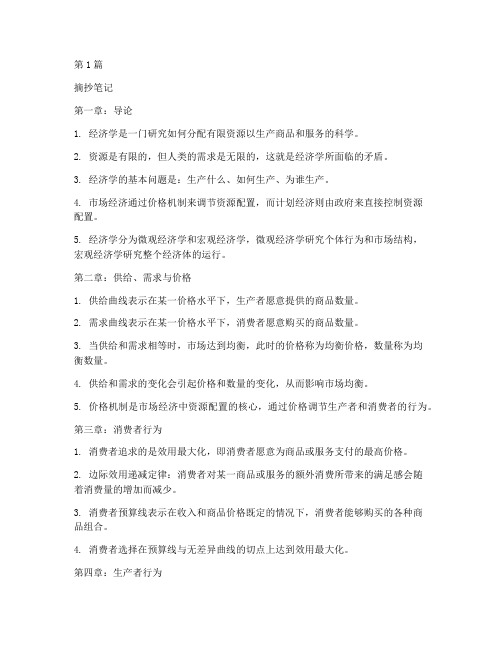
第1篇摘抄笔记第一章:导论1. 经济学是一门研究如何分配有限资源以生产商品和服务的科学。
2. 资源是有限的,但人类的需求是无限的,这就是经济学所面临的矛盾。
3. 经济学的基本问题是:生产什么、如何生产、为谁生产。
4. 市场经济通过价格机制来调节资源配置,而计划经济则由政府来直接控制资源配置。
5. 经济学分为微观经济学和宏观经济学,微观经济学研究个体行为和市场结构,宏观经济学研究整个经济体的运行。
第二章:供给、需求与价格1. 供给曲线表示在某一价格水平下,生产者愿意提供的商品数量。
2. 需求曲线表示在某一价格水平下,消费者愿意购买的商品数量。
3. 当供给和需求相等时,市场达到均衡,此时的价格称为均衡价格,数量称为均衡数量。
4. 供给和需求的变化会引起价格和数量的变化,从而影响市场均衡。
5. 价格机制是市场经济中资源配置的核心,通过价格调节生产者和消费者的行为。
第三章:消费者行为1. 消费者追求的是效用最大化,即消费者愿意为商品或服务支付的最高价格。
2. 边际效用递减定律:消费者对某一商品或服务的额外消费所带来的满足感会随着消费量的增加而减少。
3. 消费者预算线表示在收入和商品价格既定的情况下,消费者能够购买的各种商品组合。
4. 消费者选择在预算线与无差异曲线的切点上达到效用最大化。
第四章:生产者行为1. 生产者追求的是利润最大化,即生产者在生产过程中获得的最大利润。
2. 边际成本递增定律:随着生产规模的扩大,每增加一单位生产所带来的成本增加。
3. 生产者选择在边际成本等于边际收益的点上达到利润最大化。
4. 企业的生产函数描述了生产要素投入与产出之间的关系。
第五章:市场结构1. 市场结构是指市场中企业的数量、产品的同质性和进入壁垒等因素。
2. 完全竞争市场:市场上有许多企业,产品同质,进入和退出市场自由。
3. 垄断竞争市场:市场上有许多企业,产品具有差异性,进入和退出市场相对自由。
4. 寡头垄断市场:市场上有少数几家大企业,产品可能具有差异性,进入和退出市场受限制。
政治经济学原理 第四章 资本与剩余价值的具体形式
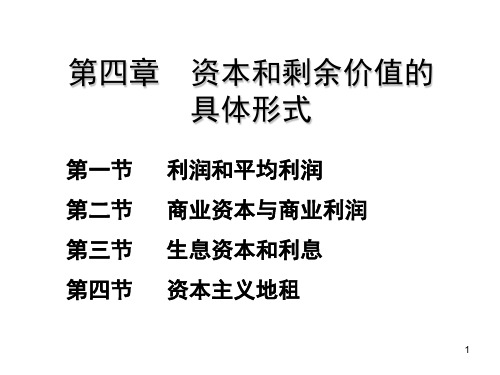
3、部门内部的竞争和超额利润的形成。
(1)超额利润是超过平均利润的利润,是超额剩余价值 的转化形式,由商品的个别生产价格低于社会生产价 格的差额构成。 (2)超额利润反映的是同一部门内部不同企业之间的关 系。生产价格形成后,利润率趋于平均化并没有排除 各个部门投资者和同一部门内部各企业之间利润率的 差别,生产率较高的企业由于商品的个别成本低于社 会平均成本,仍然可以得到超额利润。
18
二、商业利润 (一)商业利润 1、商业利润是商业资本从产业资本那里瓜分到的一部分剩余 价值,体现的是商业资本和产业资本共同瓜分剩余价值和 剥削雇佣劳动者的关系。 2、商业利润的真正来源是产业工人创造的一部分剩余价值。
(1)单纯的商品买卖不会创造价值和剩余价值。商业利润的 真正来源是产业资本转让给商业资本的产业工人创造的一 部分剩余价值 。 (2)流通领域的贱买贵卖,是商业资本取得商业利润的途径。 由于商业资本投资于商业,帮助产业资本完成商品的销售 任务,实现商品的价值和剩余价值,因此,产业资本不能 像自产自销那样独占产业工人创造的全部剩余价值,必须 把其中一部分以商业利润的方式转让给商业资本。
14
(四)部门内部的竞争与超额利润
1、部门内部的竞争,是同一生产部门生产同类商品的不 同企业之间,为获得超额利润而展开的竞争。 2、部门内部的竞争“使商品的各种不同的个别价值形成 一个相同的市场价值和市场价格”。 (1)市场价值是由部门内部竞争而形成的商品的社会价 值,是把价值同市场供求和竞争关系联系起来的范畴, 离开部门内部竞争,社会必要劳动时间决定商品的社会 价值就是一句空话。 (2)市场价格是市场价值的货币表现,是商品在市场进 行交换的价格。市场价格由市场价值决定,并受市场供 求关系的影响。平均利润率形成后,市场价格就表现为 社会生产价格的货币表现。 15
第4章 自然资源的经济学原理

自然资源的自然供给:是指实际存在于自然界的各种自 然资源的可得数量。
全球的自然资源总数量是固定的,既非人力所能创造, 也不会随价格和其他社会经济因素的变化而增减。某一 国家区域或某一用途的自然资源而言,其自然供给也是 有限度的。
自然资源的自然供给
二、自然资源的供给
2. 自然资源的经济供给
自然资源的经济供给:在自然资源的自然供给范围内, 某用途的资源供给随该用途收益的增加而增加的现象。
一、价值确定的基本理论
3. 效用价值论 边际效用价值论是在对抗古典经济学劳动价值论的背景 下,逐渐出现的。19世纪70年代初,由英国的杰文斯、 奥地利的门格尔和法国的瓦尔拉斯提出,后由奥地利的 庞巴维克和维塞尔加以发展的经济学的价值理论之一。 核心观点认为商品价值并非有劳动决定而是由效用决定。
一、价值确定的基本理论
马克思主义的劳动价值论主要包括以下内容: 1) 劳动二重性:具体劳动创造使用价值,抽象劳动创造 价值 2) 社会必要劳动时间决定价值量 ( 生产条件、熟练程度、 劳动强度) 3)商品生产过程是劳动过程和价值形成过程的统一。 4) 价值由购买生产资料的不变资本 C 、可变资本 U 和劳动 创造的剩余价值M,即价值=C+U+M。
五、自然资源供需平衡实例分析
实例:水资源供需分析 水资源供给:一个区域的水资源供给依赖于水文因素和 水利工程建设,短时间之内水资源的供给量是一定的, 不会随水价的变动而涨落。 水资源需求:大致可以分为农业用水、城市用水。随着 工业和城市的扩大和发展,城市用水需求增加,假设农 业用水需求仍不变。 水资源价格:政府基于两方面的需求,制定水价P
一、价值确定的基本理论
2. 地租论 在经济学中,地租有两种意义: 第一种是地主将土地出租给佃户,主佃之间有一种租佃 契约,规定佃户按期缴纳租金给地主,这种地租称契约 地租或商业地租。 第二种是由土地本身的价值带来的报酬,由于所有权转 化到土地所有者手中,称经济地租或纯地租。 前者是后者在封建土地制度下的一种特殊形式,后者则 是各种土地制度下都存在的普遍形式。这里所讨论的地 租是指经济地租或纯地租。 主要包括:级差地租、绝对 地租、垄断地租。
经济学原理(第四章)备考题

B、规模报酬递减
C、规模报酬不变
D、需视具体情况而定
窗体底端
答案:1、D 2、D 3、A 4、D 5、B 6、B 7、C 8、B
9、B 10、A
B、成本增加了
C、生产要素的价格按相同比例提高了
D、生产要素的价格按不同比例提高了
6.当投入要素中只有一种要素可变时,该可变要素的投入量与产量的变化可分为三个阶段,其合理使用区域即经济区
C、第三区域
D、第二区域的一部分
7.随着劳动投入要素的不断增加,劳动的边际产量在开始阶段上升,然后出现下降的趋势,那么,当总产量达到最大时( )。
D、边际产量曲线一定在平均产量曲线的最高点与之相交
9.规模报酬递减是在下述情况下发生的( )。
A、连续地投入某种生产要素而保持其它生产要素不变
B、按比例连续增加各种生产要素
C、不按比例连续增加各种生产要素
D、以上都正确
10.假设生产函数的形式为q=x^(2-α)· y^α,其中0<α<1,则该生产技术为( )。
A、平均产量等于边际产量
B、边际产量大于平均产量
C、平均产量大于边际产量
D、平均产量等于零
8.下列说法中错误的一种说法是( )。
A、只要总产量减少,边际产量一定是负的
B、只要边际产量减少,总产量也一定减少
C、随着某种生产要素投入量的增加,边际产量和平均产量增加到一定程度趋于下降,其中边际产量的下降一定先于平均产量
经济学原理(第四章 生产理论)
窗体顶端
单选题
1.如果规模报酬不变,单位时间里增加了20%的劳动使用量;但保持资本量不变,则产出将( )。
A、增加20%
B、减少20%
经济学原理考试题库完整

经济学原理考试题库完整目录- [第一章:供给和需求](#第一章:供给和需求)- [第二章:市场机制和价格](#第二章:市场机制和价格)- [第三章:弹性](#第三章:弹性)- [第四章:成本与产出](#第四章:成本与产出)- [第五章:垄断和垄断竞争](#第五章:垄断和垄断竞争) 第一章:供给和需求1. 什么是需求曲线?如何表示需求曲线?2. 什么是供给曲线?如何表示供给曲线?3. 解释需求增加和需求减少对供求平衡的影响。
4. 解释供给增加和供给减少对供求平衡的影响。
5. 解释需求曲线和供给曲线的相互作用对市场均衡的影响。
第二章:市场机制和价格1. 解释市场机制的作用和功能。
2. 什么是均衡价格?它是如何确定的?3. 解释价格上涨和价格下跌对市场均衡的影响。
4. 解释需求边际和供给边际对价格决策的影响。
5. 解释市场干预对价格和市场效率的影响。
第三章:弹性1. 什么是价格弹性?如何计算价格弹性?2. 解释价格弹性的单位弹性、完全弹性和不弹性。
3. 解释收入弹性和交叉弹性的概念。
4. 解释需求弹性对价格和收入变化的影响。
5. 解释供给弹性对价格和成本变化的影响。
第四章:成本与产出1. 什么是固定成本?如何计算固定成本?2. 解释变动成本的概念和计算方法。
3. 解释平均固定成本、平均变动成本和边际成本的概念。
4. 解释生产函数和边际产出的关系。
5. 解释长期和短期成本的区别。
第五章:垄断和垄断竞争1. 解释垄断和垄断竞争的概念。
2. 解释垄断市场的特征和行为。
3. 解释垄断竞争市场的特征和行为。
4. 解释垄断和垄断竞争对价格和产量决策的影响。
5. 解释反垄断法对垄断和垄断竞争的调节作用。
以上是一个完整的经济学原理考试题库,希望对你的学习有帮助。
请自行准备答案并进行复习。
祝你成功!。
经济学原理第四章生产与成本理论
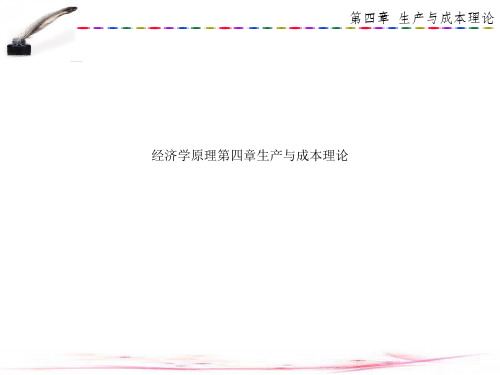
第四章 生产与成本理论
劳动的平均产量(APL)指平均每一单位可变要素劳动的 投入量所生产的产量。它的定义公式为
APL
TPL(L,K) L
(4.5)
劳动的边际产量(MPL)指增加一单位可变要素劳动的投 入量所增加的产量。它的定义公式为
MPL
TPL(L,K) L
(4.6)
第四章 生产与成本理论
或
M P L lL i0 m TL P (L L,K)dT L d(L L P ,K) (4.7)
假设等产量曲线的生产函数为
第四章 生产与成本理论
Q=f(L,K)=Q0
在等式两边取全微分得
f dLf dKdQ0 L K
整理得
第四章 生产与成本理论
f dK L MPL dL f MPK
K
由边际技术替代率定义公式可得
MRTLR KddK LM MK LPP
第四章 生产与成本理论
2. 边际技术替代率递减规律 在两种生产要素相互替代的过程中,普遍存在这么一种 现象:在维持产量不变的前提下,当一种生产要素的投入量 不断增加时,每一单位的这种生产要素所能替代的另一种生 产要素的数量是递减的。这一现象被称为边际技术替代率递 减规律。以图4-4为例。
在图4-6中,有一条等成本线AB和三条等产量曲线Q1 、 Q2和Q3。等成本线AB的位置和斜率取决于既定的成本量C
和两种生产要素的价格比例 P L 。 PK
第四章 生产与成本理论
图4-6 既定成本条件下的产量最大化
第四章 生产与成本理论
总之,在均衡点E,等产量曲线Q2与等成本线AB相切。
由于等产量曲线的斜率可用边际技术替代率MRTS表示,等
第四章 生产与成本理论
经济学原理第4章 充分就业

充分就业时的失业(shī yè)
为什么失业总是(zǒnɡ shì)存在? 两个广泛的原因:
– 寻找工作 – 工作配给
第四十五页,共七十二页。
充分就业时的失业(shī yè)
寻找工作 找到一个可接受的空位工作的活动
影响工作寻找量的其他因素: – 人口(rénkǒu)变动 – 失业津贴 – 结构变动
• 劳动生产率:每小时劳动的实际GDP • 三个影响(yǐngxiǎng)劳动生产率的因素是: • 物质资本 • 人力资本 • 技术
第八页,共七十二页。
实际(shíjì)GDP与就业
劳动生产率:物质资本 在其他条件不变的情况下,我们(wǒ men)使
用的物质资本越多,我们(wǒ men)的劳动 生产率就越高。
第九页,共七十二页。
实际(shíjì)GDP与就业
劳动生产率:人力资本 人们从教育和在职培训中得到的知识和 技能 。 (jìnéng)
干中学可以使劳动生产率可靠地提高。
第十页,共七十二页。
实际(shíjì)GDP与就业
劳动生产率:技术(jìshù)
技术对劳动生产率的深远影响。
第十一页,共七十二页。
25
年 美 元 15
工作寻找增加(zēngjiā), 失业率高于自然率
LS
寻找工作引起处于 自然率的失业
第二十页,共七十二页。
劳动(láodòng)市场---劳动 (láodòng)供给
劳动供给量是经济中所有家庭方案工作的 劳动时数。 劳动供给是在所有其他影响(yǐngxiǎng)工 作方案的因素都不变时,劳动供给量与实 际工资率之间的关系。
第二十一页,共七十二页。
劳动(láodòng)供给
经济学原理--生产理论知识
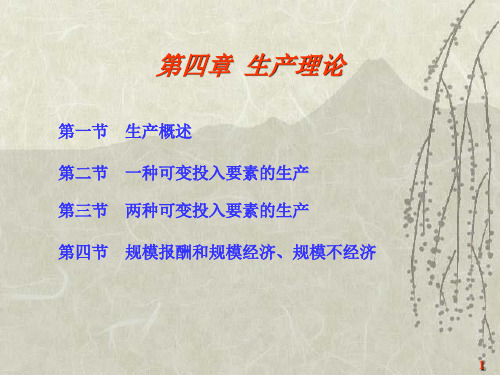
KE
E
O LE
Q3 QQ1 2 BL
(1)既定成本、产量最大
K
KE
E
O
LE
L
(2)既定产量、成本最小
27
两种可变投入的生产:五、生产要素 的最优组合
2、最优要素组合原则(条件)
MPL PL MPK PK
MPL MPK
PL
PK
28
两种可变投入的生产:五、生产要素 的最优组合
3、最优要素组合的实现
2、等成本曲线的变动
K A3
K
A1
A
A2
B3
O
B2 B1 L O
C
D
BL
25
两种可变投入的生产:五、生产要素 的最优组合
最优要素组合是指在生产技术和要素价格既定的条件 下,以既定的成本生产最大的产量或以最小的成本生产既 定的产量的要素组合。
26
两种可变投入的生产:五、生产要素 的最优组合
1、最优要素组合图 K A
40
成本和成本函数:二、成本函数
成本函数: 表示成本与最大产量之间的关系。 C = C(Q)
41
第二节 短期成本:一、短期成本概念
1、短期总成本(STC) 厂商在短期内生产 一定量的产品对全部生产要素所支
付的全部成本。它包括总固定成本和总可变成本。
总固定成本(TFC):厂商在短期内生产 一定量的产品对 固定要素所支付的全部成本。 总可变成本(TVC):厂商在短期内生产 一定量的产品对 可变要素所支付的全部成本。
38
第五章 成本理论
第一节 成本和成本函数 第二节 短期成本 第三节 长期成本 第四节 长期成本曲线和短期成本曲线的关系
39
《经济学原理》(全套课件)
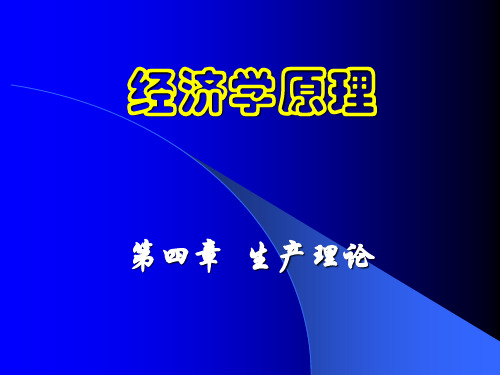
(四)常用生产函数:柯布—道格拉斯生产函数 齐次生产函数中典型生产函数,即
Cobb-Douglas production function 研究美1899-1922年间K与L对Q影响
(四) C—D函数
q A K L
A为规模参数或技术因子
α、β系数
通过研究 产量增加中约3/4是劳动贡献(即β=3/4) 1/4是资本贡献(即α=1/4) 由于α+β=1,线性齐次,显示出规模报酬不变性质
我国原指工业企业,现在包括一切拥有并经营其资 产的企业化单位(enterprise-type units)
(二)企业本质—科斯(Ronald H. Coase) 《企业的性质》交易成本论
交易成本
指仅与交换有关的成本,是除生产成本以外,为 达成协议和完成交易所耗费的成本
如收集有关交易信息,寻求交易条件,谈判和讨价还价, 监督合约实施
( q=ƒ ( L ) ) • 第四节 长期生产函数-两种变动要素的合理投入
q=ƒ ( L,K )
• 第五节 生产扩张与规模报酬 • 本章习题
一、生产和生产要素
(一)生产(production)性质
经济学十大原理
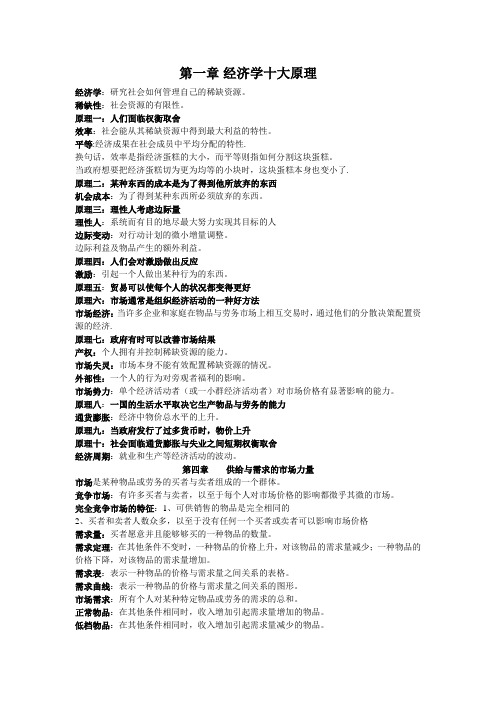
第一章经济学十大原理经济学:研究社会如何管理自己的稀缺资源。
稀缺性:社会资源的有限性。
原理一:人们面临权衡取舍效率:社会能从其稀缺资源中得到最大利益的特性。
平等:经济成果在社会成员中平均分配的特性.换句话,效率是指经济蛋糕的大小,而平等则指如何分割这块蛋糕。
当政府想要把经济蛋糕切为更为均等的小块时,这块蛋糕本身也变小了.原理二:某种东西的成本是为了得到他所放弃的东西机会成本:为了得到某种东西所必须放弃的东西。
原理三:理性人考虑边际量理性人:系统而有目的地尽最大努力实现其目标的人边际变动:对行动计划的微小增量调整。
边际利益及物品产生的额外利益。
原理四:人们会对激励做出反应激励:引起一个人做出某种行为的东西。
原理五:贸易可以使每个人的状况都变得更好原理六:市场通常是组织经济活动的一种好方法市场经济:当许多企业和家庭在物品与劳务市场上相互交易时,通过他们的分散决策配置资源的经济.原理七:政府有时可以改善市场结果产权:个人拥有并控制稀缺资源的能力。
市场失灵:市场本身不能有效配置稀缺资源的情况。
外部性:一个人的行为对旁观者福利的影响。
市场势力:单个经济活动者(或一小群经济活动者)对市场价格有显著影响的能力。
原理八:一国的生活水平取决它生产物品与劳务的能力通货膨胀:经济中物价总水平的上升。
原理九:当政府发行了过多货币时,物价上升原理十:社会面临通货膨胀与失业之间短期权衡取舍经济周期:就业和生产等经济活动的波动。
第四章供给与需求的市场力量市场是某种物品或劳务的买者与卖者组成的一个群体。
竞争市场:有许多买者与卖者,以至于每个人对市场价格的影响都微乎其微的市场。
完全竞争市场的特征:1、可供销售的物品是完全相同的2、买者和卖者人数众多,以至于没有任何一个买者或卖者可以影响市场价格需求量:买者愿意并且能够够买的一种物品的数量。
需求定理:在其他条件不变时,一种物品的价格上升,对该物品的需求量减少;一种物品的价格下降,对该物品的需求量增加。
经济学-第四章 生产理论
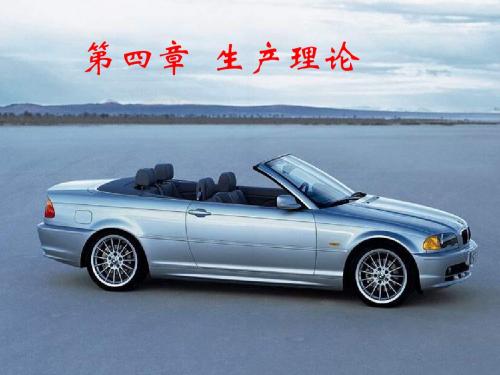
一种可变投入品生产函数可被下表所描述:
劳动力数 量(L) 0 1 2 3 4 5 6 7 8 9 10 资本数量 (K) 10 10 10 10 10 10 10 10 10 10 10 总产量 (TP) 0 10 30 60 80 95 108 112 112 108 100 平均产量 (AP) 10 15 20 20 19 18 16 14 12 10 边际产量 (MP) 10 20 30 20 15 13 4 0 -4 -8
二、边际收益递减规律
注意几点:
• (1)收益递减规律具有独立于经济制度或其它社 会条件而发生作用的普遍性或一般性。 • (2)边际收益递减规律作用前提之一“技术水平” 不变,它不否认技术条件变化可能导致劳动生产 率提高。 • (3)规律表述有“最终”二字修饰条件。也就是 说,某一投入边际收益并非自始至终递减,它有 可能在一定范围内呈现增加趋势。
K 5 E
4 3
2 1 D C A B Q3=90 Q2=75 Q1=55 3 4 L 5
0
1
2
2、等产量线的特征
(1)等产量线是一条 向右下方倾斜的曲 线。 (2)在同一平面图上 可以有无数条等产 量线,不同的等产 量线代表不同的产 量水平。
K 5 E
4
3 2 1 B D A C Q3=90 Q2=75 Q1=55 3 4 5 L
K A
利率(PK)变化使等成 本线以B点为轴心旋转。
O
B1
B2
B3
L
四、生产要素的最适组合
1、既定成本下 产量最大 2、既定产量下 成本最低
• 等成本线和等产量线 的切点。这时: • MPL / MPK = PL / PK, 即两种投入品的边际 产量比率等于它们的 价格比率。或者: • MPL / PL = MPK / PK, 即两种投入品的边际 产量与其价格比率相 等。
(完整版)《经济学原理》练习题、答案

《经济学原理》总目录第一篇导论第一章导论第二篇微观经济理论第二章需求、供给与均衡第三章消费者行为理论第四章生产者行为理论第五章产品市场理论第六章生产要素理论第七章微观经济政策第三篇宏观经济理论第八章国民收入的核算与决定理论第九章失业与通货膨胀理论第十章经济周期与经济增长理论第十一章宏观经济政策第十二章开放经济第一章导论一、单项选择1、作为经济学的两个组成部分,微观经济学与宏观经济学是()A.互相对立的B.没有任何联系的C.相互补充的D.部分联系的2、古典经济学家亚当·斯密所谓的“看不见的手”是指()A.技术B.信息C.价格D.行政命令3、经济学研究的基本问题是()A.生产什么B.如何生产C.为谁生产D.以上都是4、资源的稀缺性是指()。
A.世界上的资源最终会由于人们生产更多的物品而消耗光B.相对于人们无穷的欲望而言,资源总是不足的C.生产某种物品所需资源的绝对数量很少D.由于存在资源浪费而产生的稀缺5、微观经济学解决的问题是()。
A.资源配置B.资源利用C.市场出清D.完全理性6、宏观经济学的中心理论是()。
A.失业理论B.通货膨胀理论C.国民收入决定理论D.经济增长理论7、关于实证经济学与规范经济学说法正确的是()A.两者并不是绝对相互排斥的,而应当是相互补充的。
B.规范经济学是以实证经济学为基础,而实证经济学则是以规范经济学作为指导的。
C.一般来说,越是具体的问题,实证的成分越多,而越是高层次的、决策性的问题,就越具有规范性。
D.以上说法都对二、多项选择1、微观经济学的主要内容包括()A.体格决定理论B.消费者行为理论C.生产者行为理论D.市场理论和分配理论等2、宏观经济学的基本内容有()A.宏观经济政策B.经济周期与增长理论C.国民收入决定理论D.失业与通货膨胀理论3、下列关于资源稀缺性的正确的说法有()A.资源稀缺性是相对于欲望的无限性而言的B.地球上的资源本来就少C.资源稀缺性存在于世界各地D.资源稀缺性存在于人类历史的各个时期三、判断题1、资源的稀缺性决定了资源可以得到充分的利用,不会出现资源浪费的现象。
- 1、下载文档前请自行甄别文档内容的完整性,平台不提供额外的编辑、内容补充、找答案等附加服务。
- 2、"仅部分预览"的文档,不可在线预览部分如存在完整性等问题,可反馈申请退款(可完整预览的文档不适用该条件!)。
- 3、如文档侵犯您的权益,请联系客服反馈,我们会尽快为您处理(人工客服工作时间:9:00-18:30)。
(三)短期与长期
• 1.短期:在此期间内,至少有一种投入的 数量不变而其他投入的数量可以变动。 • 2.长期:在此期间内,一切投入的数量都 可以变动。 • 短期与长期的区别在于生产规模是否变化
8
二、一种可变投入的生产函数
• (一)总产量、平均产量和边际产量 • (二)边际报酬递减规律 • (三)总产量、平均产量和边际产量之 间的关系 • (四)生产的三个阶段
40
1. 固定成本和可变成本
• 固定成本: • ——在短期内不随产量变化而变化的 成本,即不变投入带来的成本。 • 可变成本: • ——在短期内随产量变化而变化的成 本,即可变投入带来的成本。
41
2. 总固定成本、总可变成本和总成本
• TFC——常数 • TVC= f(Q), Q—产量 • TC = TFC+TVC • = TFC+ TVC(Q)
C
18 16 14 12 10 8 6 4 2 0 -2 0 -4 -6 -8 -10
Y
2
4
6
8
10 12 14 16 18
AP
2
4
6
8
10
12
14
16
18
MP
X
y (四)生产的三个阶段
MAX(TP)
拐点
TP
二
MAX(AP)
一
MAX(MP)
三
0
AP
MP
x
生产三个阶段的特征
不变 可 变 投入 投入 TP AP
• 在总产量水平不变的前提下,随着某一 种要素投入量的增加,每增加一单位该 种要素的投入量所能够替代的另一种要 素的数量是递减的。 • 所以,等产量曲线凸向原点。
24
(二)等成本线
• ——表示所需成本相等的两种要素投入 量的全部组合方式的曲线。
TC PL L PK K
25
总成本为100元的等成本线
• (一)等产量曲线 • (二)等成本线 • (三)生产要素的最佳投入组合
17
(一)等产量曲线
• 1. 等产量曲线 • 2. 边际技术替代率 • 3. 边际技术替代率递减规律
18
1.等产量曲线
• ——表示能生产出相等产量的两种要素 投入量的全部组合方式的曲线。
TP f ( L, K )
L—劳动;K—资本;TP—总产量 TP为常数,则: K = g(L) 或 L = g(K)
5
0
3
L
K
5
最小成本组合
●
4
A
3
2
● ●C
E
B
●
1
Q[15]
C[125]
5
C[75]
C[100]
4
0
1
2
3
L
最佳投入组合条件的几何解释 MPL K 等产量线的斜率 L MPK PL 等成本线的斜率 PK MPL PL MPL MPK PL PK MPK PK PL L PK K TC[约束条件]
22
2.边际技术替代率
• ——在保持产量不变的前提下,增加一单位 某种要素的投入量而必须减少的另一种要素 的投入量。
K MRTS LK L dK 或 MRTS LK dL
K g ( L)
L g (K )
MRTS KL
L K
或 MRTS KL
23
dL dK
3.边际技术替代率递减规律
9
(一)总产量、平均产量和边际产量
• • • • TP—总产量 AP—平均产量 MP—边际产量 x—可变投入量
TP f ( x)
TP f ( x) AP x x TP df ( x) TP MP lim MP x 0 x dx x
例:一制衣厂(一台缝纫机)
总产量、平均产量与边际产量
42
3. 平均成本和边际成本
• • • • 平均固定成本:AFC = TFC / Q 平均可变成本:AVC = TVC(Q) / Q 平均总成本:ATC= TC(Q) /Q= AFC + AVC 边际成本:MC=⊿TC/⊿Q 或MC= dTC/dQ
43
(二)短期成本曲线图
• • • • • • • • 仍以经典生产函数为例。 Q =f(x)=a+bx+cx² –dx³ Q=TP——产出量,x——投入量 x=f -1(Q)——反生产函数 设a=0,b=3,c=2,d=0.1; TP=3x+2x² –0.1x³ , AP=3+2x–0.1x² , MP=3+4x–0.3x²
44
TP=3x+2x² –0.1x³
短期成本表 TC=1000+300x
可变投入 总产量 平均产量 边际产量总不变成本总可变成本 总成本 平均不变成本 平均可变成本平均总成本 边际成本 X TP AP MP TFC TVC TC AFC AVC ATC MC 0 0.0 0 0 1000 0 1000 1 4.9 4.9 6.7 1000 300 1300 204.1 61.2 265.3 44.8 2 13.2 6.6 9.8 1000 600 1600 75.8 45.5 121.2 30.6 3 24.3 8.1 12.3 1000 900 1900 41.2 37.0 78.2 24.4 4 37.6 9.4 14.2 1000 1200 2200 26.6 31.9 58.5 21.1 5 52.5 10.5 15.5 1000 1500 2500 19.0 28.6 47.6 19.4 6 68.4 11.4 16.2 1000 1800 2800 14.6 26.3 40.9 18.5 7 84.7 12.1 16.3 1000 2100 3100 11.8 24.8 36.6 18.4 8 100.8 12.6 15.8 1000 2400 3400 9.9 23.8 33.7 19.0 9 116.1 12.9 14.7 1000 2700 3700 8.6 23.3 31.9 20.4 10 130.0 13 13 1000 3000 4000 7.7 23.1 30.8 23.1 11 141.9 12.9 10.7 1000 3300 4300 7.0 23.3 30.3 28.0 12 151.2 12.6 7.8 1000 3600 4600 6.6 23.8 30.4 38.5 13 157.3 12.1 4.3 1000 3900 4900 6.4 24.8 31.2 69.8 14 159.6 11.4 0.2 1000 4200 5200 6.3 26.3 32.6 1500.0
• 可回收成本——已经发生在会计成本 中的一般可以回收的成本。 • 沉没成本——已经发生在会计成本中 的不可能回收的成本。 • ——覆水难收
36
(四)会计利润与经济利润
会计师的算法 项 目 数 量 300000 销售收益 130000 原材料费用 10000 水电费 50000 工资 10000 银行利息 经济学家的算法 项 目 数 量 300000 销售收益 130000 原材料费用 10000 水电费 50000 工资 10000 银行利息 隐含租金 隐含利息 隐含工资 会计成本 200000 经济成本 100000 经济利润 50000 10000 40000 300000
• ——已经发生的会计成本或帐面成本。 • 会计师重视历史成本 • 经济学家强调机会成本
34
(二)显性成本与隐性成本
• 显性成本:即会计成本或帐面成本; • 会计师重视显性成本 • 隐形成本:厂商使用自有生产要素应 计算的费用。 • 经济学家重视隐性成本 • 生产成本=显性成本+隐性成本
35
(三)可回收成本与沉没成本
TC PL L PK K TC PL K L PK PK
截距 斜率
(三)生产要素的最佳投入组合
• 假定技术条件和两种要素的价格都不变 ,要素最佳投入组合点就是等产量曲线 与等成本线相切的切点。
28
K
5
最大产量组合
4
3
A●
●
2
E
●C
Q[20]
1
B
1 2
●
C[100]
4
Q[15] Q[10]
不变投入 可变投入 生 产 MP 利用效率 利用效率 阶段 增
不
递
增 max 增 max >0 max 减 减
减 =0 <0
增 增 max 减 max
一 二
变
增
减 三
生产要素的合理投入区间
• 第一阶段和第三阶段: • 技术上不合理,经济上不划算。 • 第二阶段: • 可变投入的合理投入区间。
16
三、多种可变投入的生产函数
会计利润
0
(五)正常利润与超额利润
• 正常利润——企业家才能的报酬。 • 在经济分析中被看成是隐性成本的一 个组成部分。 • 超额利润——超过正常利润的那部分 利润,相当于经济利润。
38
二、短期成本分析
• (一)短期成本的分类 • (二)短期成本曲线图
39
(一)短期成本的分类
• 1. 固定成本和可变成本 • 2. 总固定成本、总可变成本和总成本 • 3. 平均成本、边际成本和总成本
劳动投入量L(人) 1 2 3 4 5 6 7
MP 3 5 4 3 2 0 -1
TP 3 8 12 15 17 17 16
AP 3 4 4 3.75 3.4 2.83 2.29
(二)边际报酬递减规律
• 假定其它生产要素的投入量都不变,仅 增加某一种生产要素的投入量,那么, 在技术水平不变的前提下,随着这种生 产要素的投入量的增加,每一单位该生 产要素所带来的产出量的增量即边际产 量最终是递减的。
